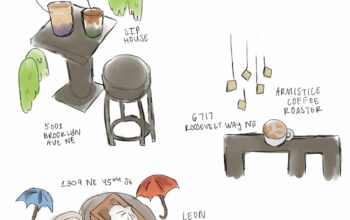It has become apparent that the recent presidential installation of Donald Trump has ushered in a surge of social discrimination, the freshest of which has been a series of false bomb threats called into Jewish Community Centers across the country. In addition to the desecration of several Jewish headstones in a Philadelphia cemetery last week, the false threats have managed only to demonstrate the capabilities of cultural intolerance in this country. Trump chose to speak about this issue at the beginning of his address to a joint session of Congress on Feb. 28, saying, “Recent threats targeting Jewish community centers and vandalism of Jewish cemeteries, as well as last week’s shooting in Kansas City, remind us that while we may be a nation divided on policies, we are a country that stands united in condemning hate and evil in all its forms.” No plan for further action was introduced.
But to perpetrate such specific and violent acts against a particular group, it takes a distinctive individual. The psychology of the bomber is vastly disparate from the psychology of an assassin or a vandal, especially a bomber that makes fake threats.
Much like cyberbullying, calling in fake bomb threats is often a faceless act. It’s a deliberate means of instilling fear but can be efficiently executed from the convenience of your own home. Social media accounts and calls can be traced to the perpetrator, but at the end of the day, a cyber bully can say “it was a joke”, and so can the fake bomber.
The fake bomber has the confidence to make a powerful claim, but either lacks the capabilities of carrying out the actual act, or is satisfied with only making threats. The fake bomber is insistent upon establishing dominance but is often maladjusted in the society they live in. The fake bomber is a coward.
The U.S. government wastes millions of dollars and a multitude of resources every year tracking down potential hidden explosives, following the leads of threats made over the phone, through letters, or through social media. Threats are seldom made in person, and almost all are fake. Former San Diego Police Department officer and workplace violence expert Dr. Steve Albrecht noted in a 2013 Psychology Today article that “real bombers bomb, they don’t make threats.”
Albrecht also mentioned notorious domestic bombers Timothy McVeigh, Ted Kaczynski, and Chechen-American brothers Dzhokhar and Tamerlan Tsarnaev, none of which made any prior threats before their goals were successfully reached. Albrecht believes that if a bomber were serious about their threats, they would do the deed without warning. This is not to say that legitimate threats should not be investigated, but that thorough evaluation should be taken beforehand. “Should we try to identify the bomb threatener, using all available technology – cell phone pings, phone traces, and Internet searches for similar threatening language? Of course. I hate crooks that make people afraid to live their lives,” Albrecht says. “But when we pull the passengers from an airliner and search it with bomb-sniffing dogs, because a flight attendant found a bomb threat written in crayon in the bathroom or some idiot called the Control Tower, we are falling right into the hands of people who make threats, as opposed to people who pose threats.”
Unfortunately, that makes the job of the FBI, Secret Service, and Marshals Service even more difficult. If a bomber truly intends to set off a bomb, without a warning or prior threat, the authorities are effectively helpless. They have no way of knowing when or where a bomb might go off or be placed, but more importantly, they have no way of knowing what may or may not even be a threat.
Needless to say, a prior threat does not completely eliminate the prospect of an actual explosive device. Sometimes threats do pan out to facilitate the discovery of a real bomb. Just not often. If a potential bomb has been discovered on scene following a recently-made threat, Albrecht believes that first responders have the capability to assess whether the device is a bomb or a fake. This helps the authorities decipher between falsified and legitimate threats, saving a myriad of time and resources. Albrecht advises citizens that “In the face of a bomb threat, first responders should look very hard for an unusual or suspicious package, bag, or device, that does not belong in or around the facility, and that has the characteristics of an explosive device: oddly-shaped, leaking, hissing, ticking, oozing, giving off a chemical smell, burnt, shaped like a pipe, having wires, batteries, etc.”
Since 9/11, sensitivity to bombings and domestic terrorism has, effectively, exploded. Every bomb threat is investigated to a certain degree, because no one can truly be sure if the threat is legitimate or not, and by the time that information is determined, it may be too late. Time will only tell if the continued presidency will make American citizens feel more or less safe.
graphic by: Nadia Kao



